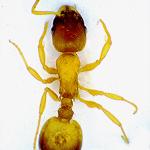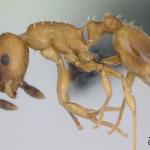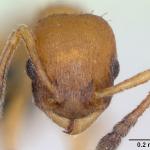Previously known as Leptothorax interruptus this species is now placed in Temnothorax (Bolton 2003). Although widely distributed in Europe, this ant is nowhere common. The small, brownish-yellow workers may be distinguished from those of the three similar British and Channel Islands species - T. albipennis, T. nylanderi and T. unifasciatus - by their combination of relatively long and typically incurved pronotal spines, darkened antennal clubs, and the possession of a dark band, interrupted in the middle, on the first gastral tergite.
The small number of British records for T. interruptus come only from the extreme south of England, where the species is currently known from heathland in Dorset and the New Forest, and from Dungeness. It has also been recorded from Hayling Island (Collingwood, 1964), Lydd-on-Sea (Felton, 1965) and Rye Harbour (Grace & Yates, 1989).
Elsewhere, this species occurs sparsely in Denmark and southern parts of Sweden and Finland, and in southern and central Europe (Collingwood 1979; Borgesen 2000; Czechowski, Radchenko & Czechowska 2002).
Listed as rare (RDB3) in Shirt (1987) and by Falk (1991).
Temnothorax interruptus colonises warm, dry, open areas with a sparse cover of low-growing vegetation. Here, it nests under moss, lichen or small flat stones, in or among old heather roots, in peat, or among the roots of fine grass (Collingwood 1979; Borgesen 2000).
Nests contain winged sexuals in July and August.
Nests are small, containing up to a few hundred workers. When constructed in the ground, a single small entrance hole leads down several centimetres to a nest chamber. During warm weather, brood is moved up from this chamber to the surface, where it is covered with small fragments of vegetation (Borgesen 2000). Typically, each nest has a single (macrogyne) queen, but nests with several smaller, mated, worker-like egg layers (microgynes) are reported from Europe (Seifert, 1996).
Workers forage singly, scavenging and hunting small arthropods. However, nestmates may be recruited individually to a large food source (Borgesen 2000). Borgesen also describes how a worker will stalk, catlike, a live springtail, before making a successful capture by jumping onto it. She also suggests that L. Interruptus workers use a chemical repellent to protect themselves from attack by other ants.
2006




